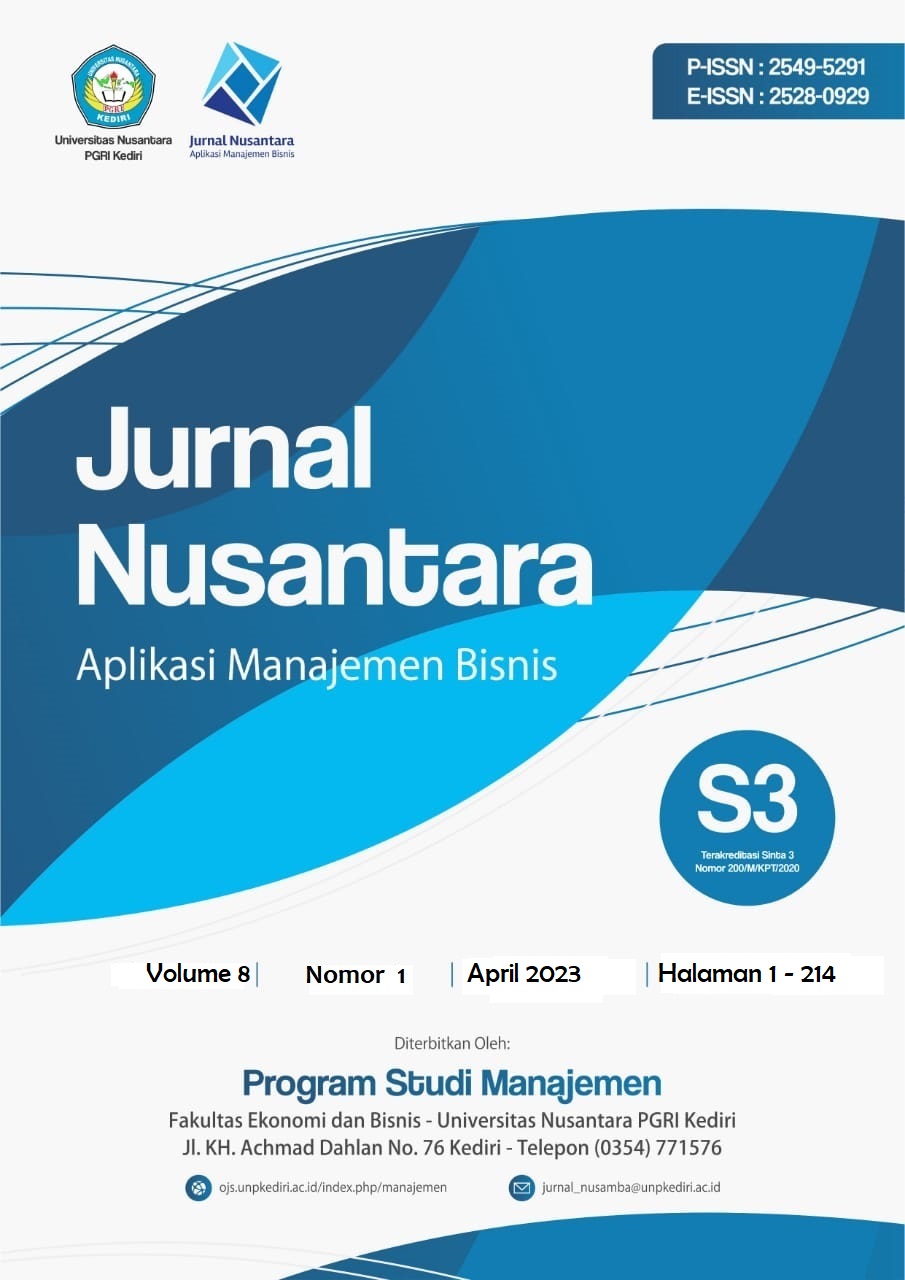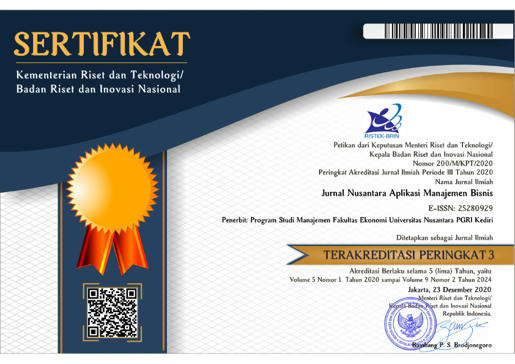Determinants Analysis of Ride-Hailing Application Acceptance: SEM - Neural Network Approach
DOI:
https://doi.org/10.29407/nusamba.v8i1.18639Keywords:
Diffusion of Innovation, Marketing Mix, Technology Acceptance, PLS-SEM, Neural NetworkAbstract
Research aim : This research aimed to develop a technology acceptance model based on innovation and marketing perspective on ride-hailing services application.
Design/Methode/Approach : This research is an explanatory quantitative research that use a primary data which collected from 303 ride-hailing services application users with questionnaire. The methods were used in this research is SEM - neural network methods. SEM is used to analysis the significant of effect of independent variable on dependent variable while neural network is used to identify the most importance independent variable on explaining dependent variable.
Research Finding : First, the SEM analysis result shows that relative advantage, price, promotion and distribution have an impact on user satisfaction. In intention to use variable furthermore, The only influencing variables are user satisfaction and distribution. Second, the results of neural network analysis on user satisfaction model shows that promotion is the most importance variable in explaining user satisfaction with followed by relative advantage, price and distribution. In neural network model of intention to use, user satisfaction is the most importance variable with followed by distribution.
Theoretical contribution/Originality : With the results of this study it can be said that there is an integration of aspects of innovation and marketing in explaining application user acceptance.
Practitionel/Policy implication : This research can be one of the considerations for the management of online transportation services to make a decision related to the service quality development, especially from the aspect of customer-based innovation and marketing.
Research limitation : The limitations in this study are limited to use of neural networks as a machine learning method and conceptual aspects of innovation and marketing in explaining application user acceptance.
Downloads
References
[2] Dabholkar PA. Consumer evaluations of new technology-based self-service options: An investigation of alternative models of service quality. Int J Res Mark 1996;13:29–51. https://doi.org/10.1016/0167-8116(95)00027-5.
[3] Paternoster N, Giardino C, Unterkalmsteiner M, Gorschek T, Abrahamsson P. Software development in startup companies: A systematic mapping study. Inf Softw Technol 2014;56:1200–18. https://doi.org/10.1016/j.infsof.2014.04.014.
[4] Prajogo DI. The relationship between innovation and business performance—a comparative study between manufacturing and service firms. Knowl Process Manag 2006;13:218–25. https://doi.org/10.1002/kpm.259.
[5] Stayton J, Mangematin V. Startup time, innovation and organizational emergence: A study of USA-based international technology ventures. J Int Entrep 2016;14:373–409. https://doi.org/10.1007/s10843-016-0183-y.
[6] Choi Y, Jin J. Is the Web Marketing Mix Sustainable in China? The Mediation Effect of Dynamic Trust. Sustainability 2015;7:13610–30. https://doi.org/10.3390/su71013610.
[7] Choi Y, Gao D. The Role of Intermediation in the Governance of Sustainable Chinese Web Marketing. Sustainability 2014;6:4102–18. https://doi.org/10.3390/su6074102.
[8] Nath P, Nachiappan S, Ramanathan R. Industrial Marketing Management The impact of marketing capability , operations capability and diversi fi cation strategy on performance : A resource-based view. Ind Mark Manag 2010;39:317–29. https://doi.org/10.1016/j.indmarman.2008.09.001.
[9] Tsao W-Y. An Assessment of Propagation Stickers in LINE Services to Promote: Toward a New Model of Diffusion Theory. J Promot Manag 2019;25:20–42. https://doi.org/10.1080/10496491.2018.1427654.
[10] Chang C-C, Liang C, Chiu Y-C. Direct or indirect effects from “perceived characteristic of innovation” to “intention to pay”: mediation of continuance intention to use e-learning. J Comput Educ 2020. https://doi.org/10.1007/s40692-020-00165-6.
[11] Kim E, Park M-C, Lee J. Determinants of the intention to use Buy-Online, Pickup In-Store (BOPS): The moderating effects of situational factors and product type. Telemat Informatics 2017;34:1721–35. https://doi.org/10.1016/j.tele.2017.08.006.
[12] Shah N, Raza SA, Qazi W. Acceptance of e-book reading among higher education students in a developing country: the modified diffusion innovation theory. Int J Bus Inf Syst 2018;27:222. https://doi.org/10.1504/IJBIS.2018.10009810.
[13] Mohammadi M, Sohrabi T. Examining the Effect of Marketing Mix Elements on Customer Satisfaction with Mediating Role of Electronic Customer Relationship Management. Ind Eng Manag Syst 2018;17:653–61. https://doi.org/10.7232/iems.2018.17.4.653.
[14] Davis FD. A TECHNOLOGY ACCEPTANCE MODEL FOR EMPIRICALLY TESTING NEW END-USER INFORMATION SYSTEMS: THEORY AND RESULTS. 1986.
[15] Venkatesh V, Morris MG, Davis GB, Davis FD. USER ACCEPTANCE OF I NFORMATION T ECHNOLOGY : TOWARD A UNIFIED VIEW. MIS Q 2003;27:425–78.
[16] DeLone WH, McLean ER. The DeLone and McLean Model of Information Systems Success: A Ten-Year Update. J Manag Inf Syst 2003;19:9–30. https://doi.org/10.1080/07421222.2003.11045748.
[17] Otaduy I, Diaz O. User acceptance testing for Agile-developed web-based applications: Empowering customers through wikis and mind maps. J Syst Softw 2017;133:212–29. https://doi.org/10.1016/j.jss.2017.01.002.
[18] Kumar A, Adlakaha A, Mukherjee K. The effect of perceived security and grievance redressal on continuance intention to use M-wallets in a developing country. Int J Bank Mark 2018;36:1170–89. https://doi.org/10.1108/IJBM-04-2017-0077.
[19] Ho K-F, Ho C-H, Chung M-H. Theoretical integration of user satisfaction and technology acceptance of the nursing process information system. PLoS One 2019;14:e0217622. https://doi.org/10.1371/journal.pone.0217622.
[20] Rogers EM. Diffusion of Innovations. Fifth. New York: Simon dan Schuster; 2003.
[21] Rogers EM. Elements of Diffusion - What is Diffusion. 1995. https://doi.org/citeulike-article-id:126680.
[22] Koenig‐Lewis N, Palmer A, Moll A. Predicting young consumers’ take up of mobile banking services. Int J Bank Mark 2010;28:410–32. https://doi.org/10.1108/02652321011064917.
[23] Plewa C, Troshani I, Francis A, Rampersad G. Technology adoption and performance impact in innovation domains. Ind Manag Data Syst 2012;112:748–65. https://doi.org/10.1108/02635571211232316.
[24] Chung K-C. Gender, culture and determinants of behavioural intents to adopt mobile commerce among the Y Generation in transition economies: evidence from Kazakhstan. Behav Inf Technol 2014;33:743–56. https://doi.org/10.1080/0144929X.2013.805243.
[25] Lin H-F. Understanding Behavioral Intention to Participate in Virtual Communities. CyberPsychology Behav 2006;9:540–7. https://doi.org/10.1089/cpb.2006.9.540.
[26] Jamshidi D, Hussin N. Islamic Credit Card Adoption Understanding: When Innovation Diffusion Theory Meets Satisfaction and Social Influence. J Promot Manag 2016;22:897–917. https://doi.org/10.1080/10496491.2016.1214206.
[27] Min S, So KKF, Jeong M. Consumer adoption of the Uber mobile application: Insights from diffusion of innovation theory and technology acceptance model. J Travel Tour Mark 2019;36:770–83. https://doi.org/10.1080/10548408.2018.1507866.
[28] Flight RL, Allaway AW, Kim W-M, D’Souza G. A Study of Perceived Innovation Characteristics Across Cultures and Stages of Diffusion. J Mark Theory Pract 2011;19:109–26. https://doi.org/10.2753/MTP1069-6679190107.
[29] Al-Jabri IM, Sohail MS. Mobile banking adoption: Application of diffusion of innovation theory. J Electron Commer Res 2012;13:379–391.
[30] Lin A, Chen N-C. Cloud computing as an innovation: Percepetion, attitude, and adoption. Int J Inf Manage 2012;32:533–40. https://doi.org/10.1016/j.ijinfomgt.2012.04.001.
[31] Jamshidi D, Hussin N. Forecasting patronage factors of Islamic credit card as a new e-commerce banking service. J Islam Mark 2016;7:378–404. https://doi.org/10.1108/JIMA-07-2014-0050.
[32] Yang S, Lu Y, Gupta S, Cao Y, Zhang R. Mobile payment services adoption across time: An empirical study of the effects of behavioral beliefs, social influences, and personal traits. Comput Human Behav 2012;28:129–42. https://doi.org/10.1016/j.chb.2011.08.019.
[33] Kotler P, Armstrong G, Harris LC, He H. Principles of Marketing. Eight Euro. Harlow: Pearson Education Limited; 2020.
[34] Mintz O, Currim IS. What Drives Managerial Use of Marketing and Financial Metrics and Does Metric Use Affect Performance of Marketing-Mix Activities? J Mark 2013;77:17–40. https://doi.org/10.1509/jm.11.0463.
[35] Dominici G. From Marketing Mix to e-Marketing Mix: a literature overview and classification. Int J Bus Manag 2009;4:17–24. https://doi.org/10.5539/ijbm.v4n9p17.
[36] Skowron L, Kristensen K. The impact of the recent banking crisis on customer loyalty in the banking sector. TQM J 2012;24:480–97. https://doi.org/10.1108/17542731211270052.
[37] Hossain A, Humayun K. Chowdhury M, Hasan S, Shamsuzzaman M, Fahim AY, Yusuf H. Khan M. Banking service in Bangladesh: The impact of service marketing mix on purchase intention of university students. Strateg Chang 2020;29:363–74. https://doi.org/10.1002/jsc.2335.
[38] Lee JJ, Ma Z. How do consumers choose offline shops on online platforms? An investigation of interactive consumer decision processing in diagnosis-and-cure markets. J Res Interact Mark 2021;ahead-of-p:1–34. https://doi.org/10.1108/JRIM-03-2020-0046.
[39] Kar AK. What Affects Usage Satisfaction in Mobile Payments? Modelling User Generated Content to Develop the “Digital Service Usage Satisfaction Model.” Inf Syst Front 2020. https://doi.org/10.1007/s10796-020-10045-0.
[40] Xu X, Thong JYL, Tam KY. Winning Back Technology Disadopters: Testing a Technology Readoption Model in the Context of Mobile Internet Services. J Manag Inf Syst 2017;34:102–40. https://doi.org/10.1080/07421222.2017.1297172.
[41] Berman R, Hernandez-Lagoz P. Predicting Startup Survival Using the Normalized Burn Rate 2017:1–33.
[42] Ahmad AMK, Al-Qarni AA, Alsharqi OZ, Qalai DA, Kadi N. The Impact of Marketing Mix Strategy on Hospitals Performance Measured by Patient Satisfaction: An Empirical Investigation on Jeddah Private Sector Hospital Senior Managers Perspective. Int J Mark Stud 2013;5:210–27. https://doi.org/10.5539/ijms.v5n6p210.
[43] Maziriri ET, Mapuranga M, Mushwana J, Madinga NW. Antecedents That Influence the Intention to Use the Uber Mobile Application: Customer Perspectives in South Africa. Int J Interact Mob Technol 2020;14:76. https://doi.org/10.3991/ijim.v14i08.10632.
[44] Kotler P, Armstrong G. Principles of Marketing. 12th ed. New Jersey: Prentice-Hall; 2006.
[45] Thieu BT, Hieu NTM, Huyen NT Le, Binh PC, Hoang NV. Linkages between Marketing Mix Components and Customer Satisfaction: An analysis on Google in Hanoi, Vietnam. J Econ Bus Res 2017;23:123–48.
[46] Kushwaha GS, Agrawal SR. An Indian customer surrounding 7P׳s of service marketing. J Retail Consum Serv 2015;22:85–95. https://doi.org/10.1016/j.jretconser.2014.10.006.
[47] Hair JF, Black WC, Babin BJ, Anderson RE. Multivariate Data Analysis. Eight. Hampshire: Cengage Learning; 2019.
[48] Hair JF, Sarstedt M, Hopkins L, Kuppelwieser VG. Partial least squares structural equation modeling (PLS-SEM): An emerging tool in business research. Eur Bus Rev 2014;26:106–21. https://doi.org/10.1108/EBR-10-2013-0128.
[49] Chong AY. A two-staged SEM-neural network approach for understanding and predicting the determinants of m-commerce adoption. Expert Syst Appl 2013;40:1240–7. https://doi.org/10.1016/j.eswa.2012.08.067.
[50] Hair JF, Hult GTM, Ringle CM, Sarstedt M. A Primer on Partial Least Squares Structural Equation Modeling (PLS-SEM). 2nd ed. Thousand Oaks, CA: SAGE; 2017.
[51] Ooi KB, Tan GWH. Mobile technology acceptance model: An investigation using mobile users to explore smartphone credit card. Expert Syst Appl 2016;59:33–46. https://doi.org/10.1016/j.eswa.2016.04.015.
[52] Rahi S. Research Design and Methods: A Systematic Review of Research Paradigms, Sampling Issues and Instruments Development. Int J Econ Manag Sci 2017;6:5. https://doi.org/10.4172/2162-6359.1000403.
[53] Chin W. Issues and Opinion on Structural Equation Modeling. MIS Q 1998;22:1–14.
[54] Henseler J, Ringle CM, Sarstedt M. A new criterion for assessing discriminant validity in variance-based structural equation modeling. J Acad Mark Sci 2015;43:115–35. https://doi.org/10.1007/s11747-014-0403-8.
[55] Sohaib O, Hussain W, Asif M, Ahmad M, Mazzara M. A PLS-SEM Neural Network Approach for Understanding Cryptocurrency Adoption. IEEE Access 2020;8:13138–50. https://doi.org/10.1109/ACCESS.2019.2960083.
[56] Wetzels M, Odekerken-Schröder G, van Oppen C. Using PLS Path Modeling for Assessing Hierarchical Construct Models: Guidelines and Empirical Illustration. MIS Q 2009;33:177. https://doi.org/10.2307/20650284.
[57] Maozhun S, Ji L. Improved Garson algorithm based on neural network model. 2017 29th Chinese Control Decis. Conf., IEEE; 2017, p. 4307–12. https://doi.org/10.1109/CCDC.2017.7979255.
[58] Sharma SK. Integrating cognitive antecedents into TAM to explain mobile banking behavioral intention : A SEM-neural network modeling. Inf Syst Front 2019;21:815–827. https://doi.org/10.1007/s10796-017-9775-x.
[59] Zabukovšek SS, Kalinic Z, Bobek S, Tominc P. SEM–ANN based research of factors’ impact on extended use of ERP systems. Cent Eur J Oper Res 2019;27:703–35. https://doi.org/10.1007/s10100-018-0592-1.
[60] Foo P-Y, Lee V-H, Tan GW-H, Ooi K-B. A gateway to realising sustainability performance via green supply chain management practices: A PLS–ANN approach. Expert Syst Appl 2018;107:1–14. https://doi.org/10.1016/j.eswa.2018.04.013.
[61] Liébana-Cabanillas F, Marinković V, Kalinić Z. A SEM-neural network approach for predicting antecedents of m-commerce acceptance. Int J Inf Manage 2017;37:14–24. https://doi.org/10.1016/j.ijinfomgt.2016.10.008.
[62] Pozón-López I, Higueras-Castillo E, Muñoz-Leiva F, Liébana-Cabanillas FJ. Perceived user satisfaction and intention to use massive open online courses (MOOCs). J Comput High Educ 2020. https://doi.org/10.1007/s12528-020-09257-9.
Downloads
Published
Issue
Section
License
Authors who publish with this journal agree to the following terms:
- Copyright on any article is retained by the author(s).
- The author grants the journal, the right of first publication with the work simultaneously licensed under a Creative Commons Attribution License that allows others to share the work with an acknowledgment of the work’s authorship and initial publication in this journal.
- Authors are able to enter into separate, additional contractual arrangements for the non-exclusive distribution of the journal’s published version of the work (e.g., post it to an institutional repository or publish it in a book), with an acknowledgment of its initial publication in this journal.
- Authors are permitted and encouraged to post their work online (e.g., in institutional repositories or on their website) prior to and during the submission process, as it can lead to productive exchanges, as well as earlier and greater citation of published work.
- The article and any associated published material is distributed under the Creative Commons Attribution-ShareAlike 4.0 International License












